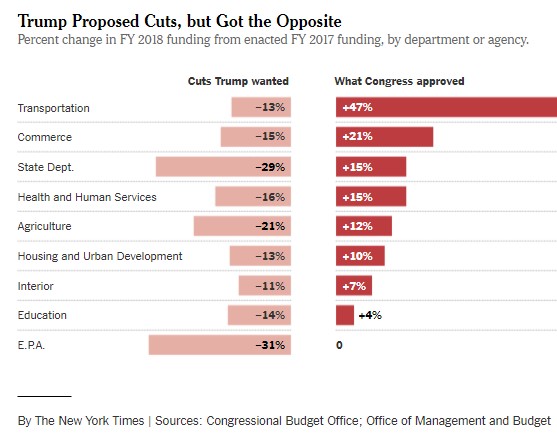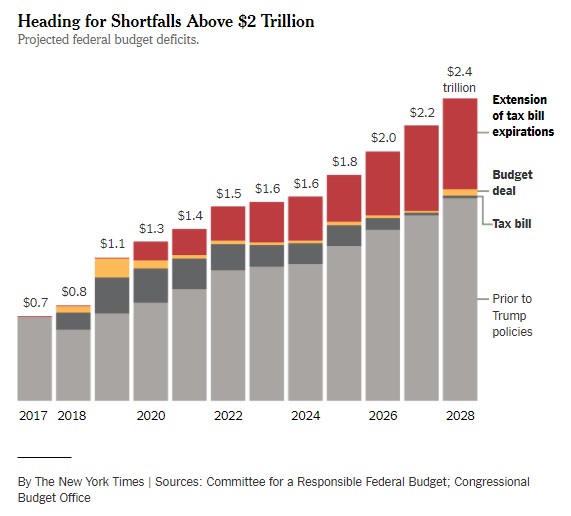Originally appeared in the New York Times.
Even by Trumpian standards, the president has been in high dudgeon this week, railing about everything from illegal immigrants to unfair Chinese trade practices. For that, at least some Trump watchers blame his smashing defeat in the passage on March 23 of the omnibus spending bill.
That legislation, approved to avert a government shutdown, brushed aside all of President Trump’s plans to restructure the federal government (except for his push for higher military spending). Even his treasured border wall got virtually nothing.
At its core, the bill was simply another exercise in kicking the can down the road with a new twist: Congress blasted through longstanding spending caps, dispensing goodies to all.
While proponents of more military spending got their wish, to win needed Democratic votes the Republicans were compelled to permit a similar increase in domestic spending.
The consequence: a huge blow to the Trump administration’s goal of dramatically shrinking the federal government.
Spending has been held down for years by the past failure of efforts to more fundamentally reorder the government’s fiscal policy. This time around, the pressure cooker exploded, at least partly.
As the chart below shows, total discretionary spending (which doesn’t include entitlement programs like Social Security and Medicare) will rise in the current fiscal year, which began Oct. 1, by 12.9 percent, the largest increase in at least four decades.
In effect, Congress nearly obliterated all the efforts in recent years to hold down spending. Outlays this year will be only 3.4 percent below what was projected in March 2011, before the budget cutting began.
What’s perhaps even more striking is the extent to which Congress simply ignored the budget submitted by the president just a few months earlier. As the chart below shows, many agencies that Mr. Trump sought to dramatically downsize instead were rewarded with increases.
Indeed, every cabinet department and significant agency got a spending increase, many of them substantial.
A flotilla of Trump targets – including the Internal Revenue Service, the Census Bureau and the National Institutes of buy celebrex Health – also received raises. An extra $1 billion was allocated for rural airports and another $1 billion went into the Highway Trust Fund. New programs were also created; a plan to bring high-speed internet to rural areas received $600 million. And on and on.
And then there were the agencies and programs that Mr. Trump wanted to eliminate altogether. Not a single one ended up on the chopping block, and many saw their budgets increase:
Community Development Block Grants
National Endowment for the Arts
National Endowment for the Humanities
Corporation for Public Broadcasting
Overseas Private Investment Corporation
Food for Peace
U.S. Trade and Development Agency
Particularly noteworthy was the resolution of the impasse of the Gateway rail tunnel to connect Manhattan with New Jersey. Led by Senate minority leader Charles E. Schumer, the Democrats wanted $900 million appropriated to begin work; Mr. Trump wanted zero.
Outcome: Mr. Schumer gets $540 million, enough to tide the project over until the next round of budget discussions.
“I’m getting tired of all this winning,” Matt House, Mr. Schumer’s communications director, tweeted.
Then there’s the wall with Mexico, yes, the one that Mexico was supposed to pay for. With no support forthcoming from our southern neighbor, the Trump administration requested $25 billion to begin work on the wall.
The amount appropriated: $1.6 billion, of which only $38 million can be used for planning for the wall. The balance is for new technology, repairs to existing barriers and 33 miles of fencing that was authorized in 2006.
This legislative fiasco underscores the need for more fundamental reform of the nation’s budgeting process. Between the tax cut voted last December and the spending increases that were just approved, the deficit for the current fiscal year will grow to an astounding $753 billion, up from $665 billion last year.
And that’s just the start. For the first time in history, we are now looking at projected budget deficits of more than $1 trillion as far as the eye can see. That means that the national debt, which sits at $20 trillion, could rise to $29 trillion or more over the next decade.
Moreover, even keeping deficits to these irresponsible levels assumes continued economic growth at roughly current levels – no recessions, no hiccups, no bumps between now and 2028.
The president seemed to understand the magnitude of his defeat, threatening in a tweet to veto the bill before capitulating and signing it. In that tweet, the President had an idea for how to improve the budgeting process: Congress should give him a line-item veto.
Unfortunately, what the president didn’t seem to know is that the line-item veto was declared unconstitutional by the Supreme Court, and Congress doesn’t have the authority to override that decision.








